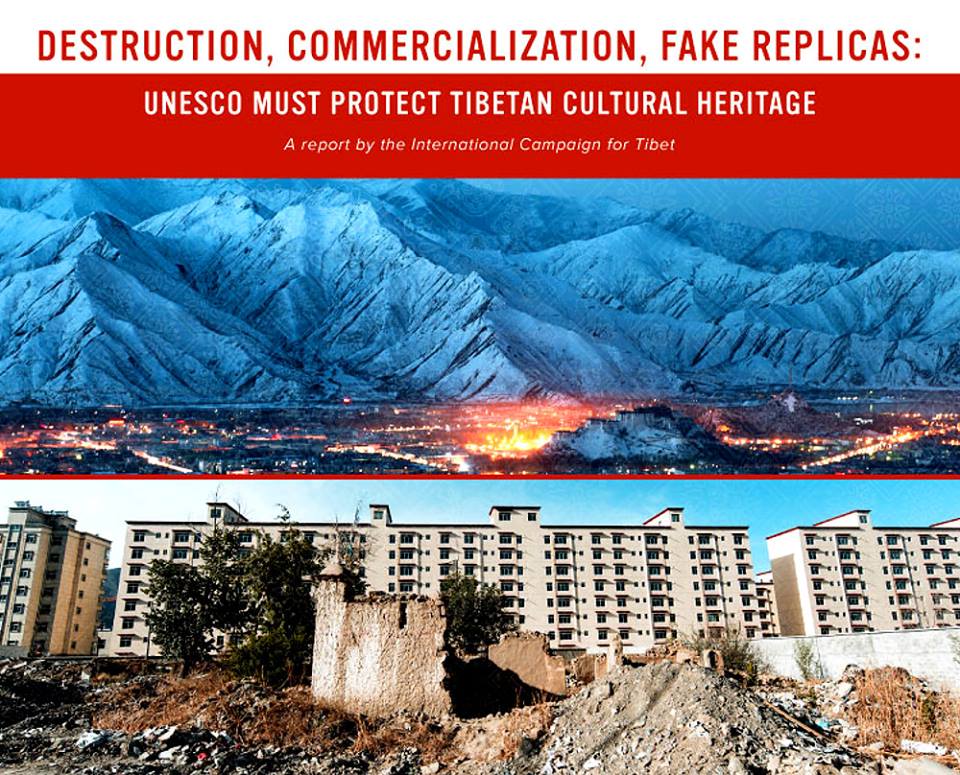
A new report by the International Campaign for Tibet reveals how Lhasa’s unique and precious remaining cultural heritage is at risk as China flouts its responsibilities under the UNESCO World Heritage Convention. The U.N. organisation for protecting the world’s heritage meets this week in Bahrain (June 24-July 4) and will vote on a decision requesting information from China about the state of conservation in Tibet’s historic and cultural capital.
In ‘Destruction, commercialization, fake replicas’, the International Campaign for Tibet reports:
- Since the Dalai Lama’s former home, the iconic Potala Palace, and other significant buildings were recognized as UNESCO World Heritage, dozens of historic buildings have been destroyed and replaced by fake ‘Tibetan’-style architecture. Official Chinese planning documents obtained by the International Campaign for Tibet confirm that this is set to continue with the remaining historic buildings, which number around 50 as new construction continues at a staggering rate.
- Four months on from a major fire at the holy Jokhang Temple in the heart of the city, once the center of Tibetan Buddhism and with a pivotal role in Tibetan civilization, the Chinese government is still blocking access and information and may be covering up substantial damage with inappropriate repair work. No foreign journalists or heritage experts have been allowed to visit Lhasa to ascertain the situation although the Chinese authorities acknowledged to UNESCO, a month after the event, that damage to the unique and irreplaceable temple is extensive.
- Compounding the threat, in a political climate of total surveillance, active engagement or promotion of heritage issues by Tibetans in Lhasa today can be dangerous.
- Official planning documents reveal that development in the interests of securitization and the Party state’s ideological imperatives are a key priority with conservation barely mentioned. The acute threat to the UNESCO World Heritage ‘Potala Palace Historic Ensemble’ is linked to a dramatic increase in Chinese domestic tourism and a rapidly expanding infrastructure in which Lhasa is a center of a new network of roads, railways and airports with dual military and civilian use, reflecting the region’s strategic significance to the Chinese government.
- The ancient circumambulation route known as the Lingkor, which takes pilgrims around a number of holy sites in Lhasa, has been disrupted by often impassable new roads and Chinese buildings.
Bhuchung Tsering, Vice President of the International Campaign for Tibet, said: “UNESCO must be vigilant in enforcing the World Heritage Convention and take serious measures for the protection of Lhasa’s remaining cultural heritage. As the United Nations body tasked with the protection of the world’s irreplaceable natural and cultural wonders, at the meeting in Bahrain the UNESCO World Heritage Committee must act in accordance with its mandate, and should seriously question the urban plans imposed by a government that has already destroyed many historic buildings. UNESCO should require the Chinese government to adopt an authentic conservation approach in order for the remaining fragments of old Lhasa to be preserved, based on a detailed plan to protect the historic Barkhor area and buildings in the ‘Potala Palace Historic Ensemble’.
Importantly, the Committee and member states of the world’s leading heritage organisation should ensure urgent access for independent verification of the status of the unique and precious architecture of the Jokhang temple, and its statues and murals, with a view to ensuring that repair work is conducted under the supervision of accredited conservation experts.”